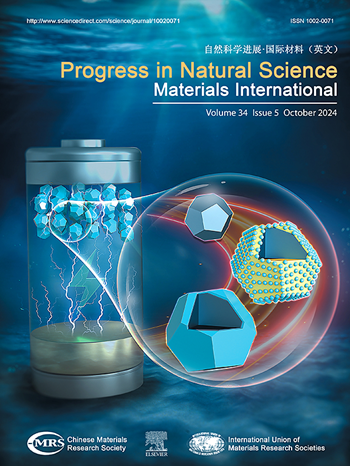Emerging organic carbonyl small molecules cathode materials in alkali-ion batteries: Principles, recent progresses, strategies and prospects
IF 7.1
2区 材料科学
Q2 MATERIALS SCIENCE, MULTIDISCIPLINARY
Progress in Natural Science: Materials International
Pub Date : 2025-02-01
DOI:10.1016/j.pnsc.2024.10.008
引用次数: 0
Abstract
Carbonyl small molecule compounds hold great potential as cathode materials for alkali-ion batteries (AIBs) due to their environmental friendliness, structural designability, and high theoretical capacity. However, it's practical application is hindered by intrinsic drawbacks, such as low electrical conductivity and high solubility in organic electrolytes. Additionally, most carbonyl small molecule cathodes can't be charged first in half-cells due to the absence of detachable Li+/Na+/K+ ions, diminishing their appeal when assembled into full cells with alkali-free anodes. This review provides a detailed overview of carbonyl-contained small molecule cathode materials centered around oxygen, including their charge storage mechanisms, solutions to overcome their drawbacks, and the latest research advancements in AIBs. This review also summarizes the electrochemical performance of carbonyl small molecules as cathodes that have been assembled in batteries. Finally, the review outlines the prospects and directions for future research on carbonyl small molecule cathodes. It is hoped that this review will offer meaningful guidance for the development of carbonyl small-molecule cathode materials in AIBs.
碱离子电池中新兴的有机羰基小分子正极材料:原理、最新进展、策略与展望
羰基小分子化合物具有环境友好、结构可设计性强、理论容量大等优点,在碱离子电池正极材料领域具有广阔的应用前景。然而,它的实际应用受到固有缺陷的阻碍,例如低导电性和在有机电解质中的高溶解度。此外,由于缺乏可分离的Li+/Na+/K+离子,大多数羰基小分子阴极不能在半电池中首先充电,这降低了它们在装配成具有无碱阳极的完整电池时的吸引力。本文综述了以氧为中心的含羰基小分子正极材料的电荷存储机制、克服其缺点的方法以及其最新研究进展。综述了羰基小分子作为阴极在电池中组装的电化学性能。最后,对羰基小分子阴极的研究进行了展望和展望。希望本文对羰基小分子阴极材料在aib中的应用具有一定的指导意义。
本文章由计算机程序翻译,如有差异,请以英文原文为准。
求助全文
约1分钟内获得全文
求助全文
来源期刊
CiteScore
8.60
自引率
2.10%
发文量
2812
审稿时长
49 days
期刊介绍:
Progress in Natural Science: Materials International provides scientists and engineers throughout the world with a central vehicle for the exchange and dissemination of basic theoretical studies and applied research of advanced materials. The emphasis is placed on original research, both analytical and experimental, which is of permanent interest to engineers and scientists, covering all aspects of new materials and technologies, such as, energy and environmental materials; advanced structural materials; advanced transportation materials, functional and electronic materials; nano-scale and amorphous materials; health and biological materials; materials modeling and simulation; materials characterization; and so on. The latest research achievements and innovative papers in basic theoretical studies and applied research of material science will be carefully selected and promptly reported. Thus, the aim of this Journal is to serve the global materials science and technology community with the latest research findings.
As a service to readers, an international bibliography of recent publications in advanced materials is published bimonthly.

 求助内容:
求助内容: 应助结果提醒方式:
应助结果提醒方式:


